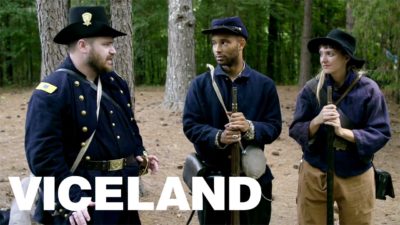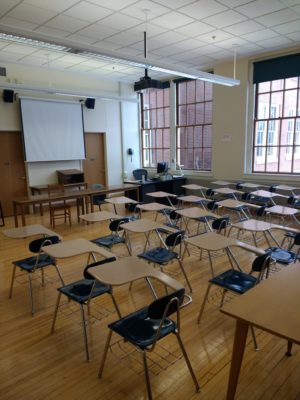Learning from Our Mistakes When Teaching Public History
24 December 2018 – Evan Faulkenbury

Video screenshot from “VICE Does America: The Civil War Reenactment” (2016)
Most days, my Introduction to Public History classes go well, but this one was a complete bust. I wanted to introduce my class of 30 undergraduate students to the world of American Civil War reenactment and to discuss its implications for public history. Should we consider reenactments as representative of public history’s ideals? What are the pros and cons of participating in or observing former battles? To get started, I played a short video from Viceland with journalists participating in a reenactment, but that’s where the trouble started. There’s some odd material in the video, and rather than act as a conversation starter, it just led to giggles and rolled eyes. Class discussion went nowhere fast.
I became a bit flustered, then hurriedly went into the next class portion where I handed out one-page biographies of actual Union troops from Cortland, New York, asked my students to read the details, and then try to transform into those long-dead soldiers. Well, this didn’t work out so well, either. They found the details monotonous and lacking interest, and when I tried to have them speak as their soldier identity, they just rattled off details from the sheet of paper. I realized then that I hadn’t prepared adequately for this class, and as student yawns became contagious, I decided to throw in the towel and dismiss class early. I walked back to my office feeling embarrassed that I had led such a stinker of a class.
Have you ever read I’m the Teacher, You’re the Student: A Semester in the University Classroom by the historian Patrick Allitt? If not, you should. It’s a book I return to, and especially after classes like this one, remembering portions of Allitt’s book help me put my teaching back into perspective. Combining humor, warmth, insight, and frustration, Allitt takes readers on a journey through one of his history courses at Emory University for an entire semester. The book offers a fascinating look inside a college classroom, encompassing everything from syllabus creation and grading procedures to reflections on individual class lectures and interactions with students. In his preface, Allitt wrote, “It’s a great life being a college professor, and the best part of the job is the teaching.” And yet, while the primary work of a history professor takes place inside classrooms, Allitt noted the dearth of books about actual teaching. “It’s strange, isn’t it, that of the tens of thousands of books produced by academics in recent years, hardly any have been about our actual work?”[1]
Although important public history textbooks have been published in the last few years, including ones by Thomas Cauvin and Cherstin M. Lyon, Elizabeth M. Nix, and Rebecca K. Shrum, as have a number of essays in The Public Historian and History@Work that include teaching practices, the field of public history lacks such pedagogical, first-person books using Allitt’s model. What was so unique about Allitt’s book was that it was personal, narrative, and relatable—like the diary of a history professor. Readers can feel what works and what doesn’t, and through Allitt’s successes and failures in the classroom, they can imagine how similar ideas might play out in their own courses. If we’re to learn from our failures as well as our successes, public history instructors could use more lessons from inside one another’s classrooms.
In particular, what we need are stories. We don’t have enough real-life, narrative case studies of full semester-length public history courses told from the instructor’s perspective. We have many excellent resources for how to put our courses together, ideas to test out, and lessons to impart, but not enough reflective pieces about what went right and what went wrong. Especially now, as our public history courses are soaring in popularity, what could be useful is a set of honest essays that pull back the curtain on our teaching styles and methods.

An empty classroom at SUNY Courtland. Photo credit: Evan Faulkenbury.
Sometimes, teaching can be lonely; even though we’re constantly interacting with our students, our role as classroom leader feels isolated from the hundreds of other public history instructors leading classes at the same time. But maybe there’s a way to break the seclusion, and in so doing, gain new pedagogical perspectives. Often, the best way to learn and generate new ideas is to pop the hood and look inside the mechanics of someone else’s course.
The problem of definition has plagued our field, but the act of teaching public history helps us refine what exactly public history means. In her recent NCPH presidential address and subsequent article in The Public Historian, Alexandra M. Lord encouraged us “to broaden the definition of public history itself.”[2] Through shared stories of our teaching methods and student interactions, we can begin to do just that.
Along with Dr. Julia Brock from the University of Alabama, I have submitted a proposal to the University of North Carolina Press for an edited collection of essays about the teaching of public history. Drawing on Allitt’s model, we plan to offer a series of case studies by instructors about the day-to-day teaching of a semester-long public history course. First-person, narrative stories about a professor’s thought process, preparations, class sessions, interactions with students, assignments, evaluations, projects, and community partner relationships have the potential to reshape our thinking about public history pedagogy.
If you find these ideas interesting, we encourage you to read our call for contributors and submit an abstract by Friday, February 1, 2019. Together, our stories about our successes—and yes, our failures—in the classroom can encourage one another, stimulate new ideas about practice and pedagogy, and push public history education into new directions.
~Evan Faulkenbury is an assistant professor of history at SUNY Cortland. Follow him on Twitter @evanfaulkenbury.
[1] Patrick Allitt, I’m The Teacher, You’re the Student: A Semester in the University Classroom (Philadelphia: University of Pennsylvania Press, 2004), ix. (Both quotes).
[2] Alexandra M. Lord, “Finding Connections,” The Public Historian 40, no. 2 (May 2018), 11.



